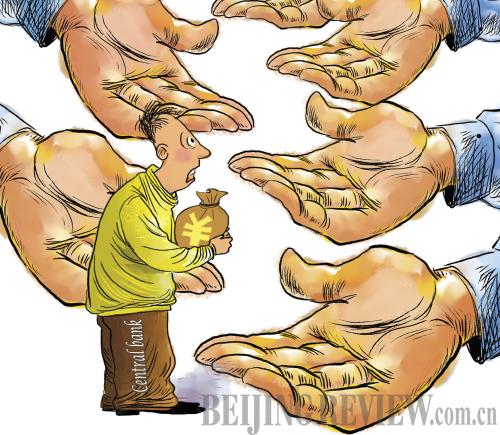Has China's banking sector entered a crunch time?
Updated: 2013-07-02 11:19
(bjreview.com.cn)
|
|||||||||||
China's central bank is determined to guide more money into the real economy while curbing unsavory credit growth.
|
 |
| [Photo / CFP] |
In a typical hot summer in China, investors never felt chillier amid a rout in the stock market.
On June 24, the benchmark Shanghai Composite Index plummeted 5.3 percent, the biggest single-day slump in four years, to 1,963.24 points. The next day, Chinese stocks touched a four-and-a-half-year low before a late rally. The steep decline marked the first time since January 2009 that the Shanghai Composite Index had fallen below 1,900 points.
The markets tumbled because of mounting concerns over an exacerbating credit crunch in China's banking system amid the central bank's hawkish stance to not inject as much liquidity as Chinese commercial banks had gotten accustomed to.
The liquidity squeeze in the banking sector is best evidenced by a sharp spike in interbank lending rates since mid-May. On June 20, the Shanghai interbank overnight rate, a gauge of interbank borrowing costs, climbed to a record high of 13.44 percent.
As usual, commercial banks turned to the People's Bank of China (PBOC), the country's central bank, for help, only to find the central bank turned its back on the distress. On June 24, the central bank urged commercial banks to control for risks associated with credit expansion and manage their liquidity.
To cushion the impact from the global financial crisis in 2008, China unleashed a monetary stimulus package in an attempt to prevent the economy from being dragged down. And the government-led credit boom has been one of the key contributors to China's economic growth in recent years. However, an explosive credit boom was coupled by mounting risks, which became a ticking time-bomb threat to the world's second largest economy.
Related Stories
CBRC says liquidity ample in banking system 2013-06-30 02:51
China fights hard battle against shadow banking 2013-06-29 13:50
No liquidity shortage in banks 2013-06-29 10:53
Breaking bad habits 2013-06-29 07:37
Prudent monetary policy to stay 2013-06-29 03:45
PBOC's caution amid cash crunch will pay off 2013-06-28 14:50
Today's Top News
Tokyo warned not to resort to 'empty talk'
No quick end in sight for Beijing smog
China, Russia to hold joint military drills
Snowden applies for Russian asylum
Forum aims to prevent sexual assaults against children
Anti-dumping probes into EU wines
New home prices defy curbs
Chinese petitioning goes online
Hot Topics
Lunar probe , China growth forecasts, Emission rules get tougher, China seen through 'colored lens', International board,
Editor's Picks

|

|

|

|

|

|





